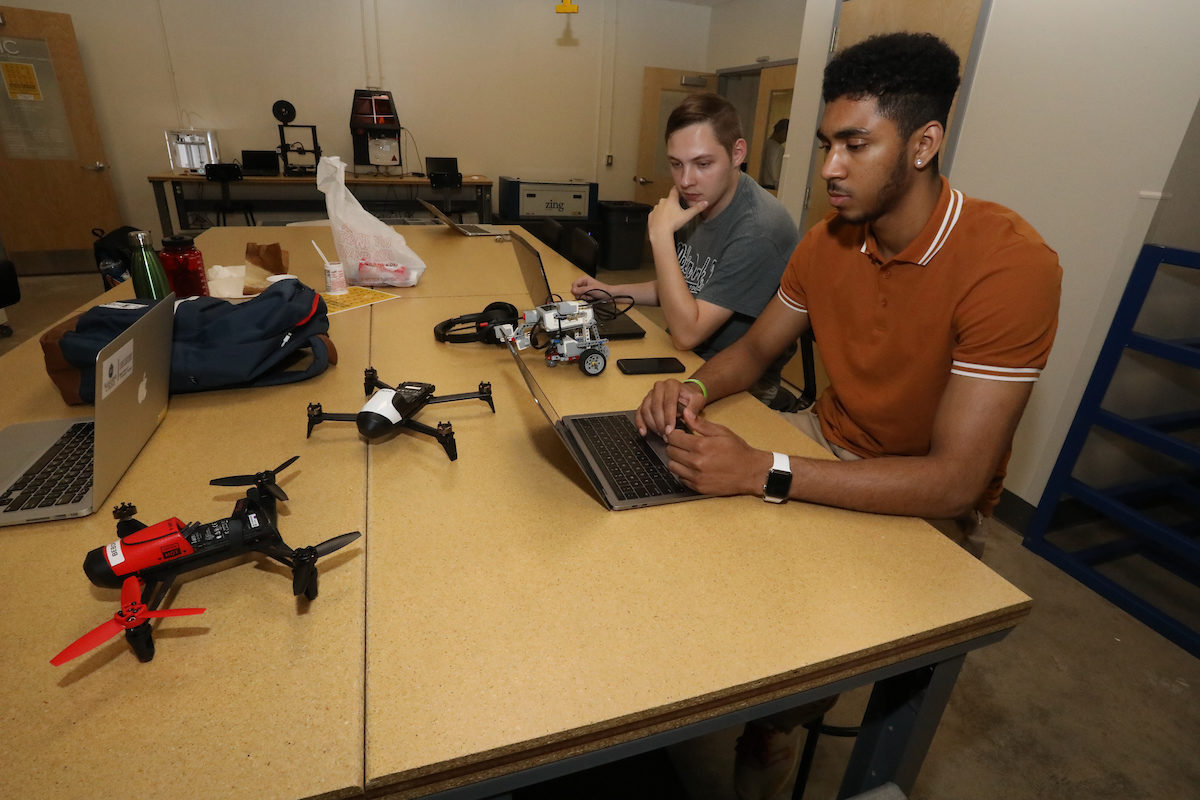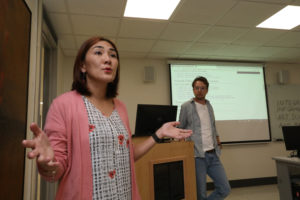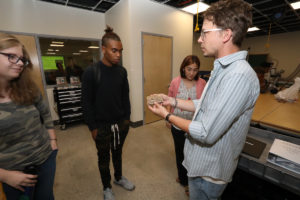
Allegheny’s New Innovation and Creativity Lab Brings Technology to the Students
When you enter the new Allegheny Lab for Innovation and Creativity, you walk into a space bristling with cutting-edge technology. In the fabrication lab, there’s a bank of 3D printers, a laser cutter and a three-axis CNC machine. Go a little further and you enter a computer design lab with neatly aligned rows of workstations, where students envision robots that will carry out tasks such as sampling soil and water.
It’s a very different looking teaching space on the campus of a liberal arts college such as Allegheny.
“It allows students to work with these technologies in a mindful way,” says Byron Rich, director of art, science and innovation at Allegheny. The world is better off having Allegheny College graduates who also have these industry-standard skills.”

The innovation center opened in the fall of 2019 as a campus-wide resource for students, staff and faculty to see their ideas move from paper to prototype. Rich oversees the innovation center, which is located in the Doane Hall of Art. There is also a part-time technology advisor, Eric Charlton, and 10 work-study students who help introduce users to the lab, which is open 60 hours every week.
The lab can facilitate 3D printing, computer numerical control machining, laser cutting, app development, photo editing, video editing, sound editing, graphic design, computer-aided design, geographic information system mapping, game design, visualization, robotics projects and much more, Rich says.
The 3D printers allow users to build actual working parts for machinery; the laser cutter cuts and etches a variety of materials, including acrylics, and is used extensively in robotics work, and the CNC machine cuts complex shapes in materials quickly.
“I’m a huge believer in technology and knowing how to use it,” says Rich, who also is an assistant professor of art. “Understanding how something is made makes you appreciate the work that goes into it.
“I consider this as applied liberal arts,” Rich continues as he strolls around the lab demonstrating the different technologies on display. “It encourages critical thinking about technology’s effect on the workforce and the planet. It moves technology from the abstract to the incredibly tangible.”
Janyl Jumadinova, assistant professor of computer science, conducts some of her classes in the facility. “The innovation center allows me to easily merge my research, teaching, and community work practices into one space. Teaching ‘Robotic Agents’ in the center last semester was amazing,” Jumadinova says.
“We were able to seamlessly move from the conceptual discussions in the classroom to software development to robot design and development in the maker space,” she adds. “Students utilized the equipment in the lab to extend robotic platforms by, for example, 3D printing landing and protective gear for the drones, and building ramps for wheeled robot navigation. For our class’s culminating Festival of Robots community outreach event, using the resources of the lab, we were able to put together a drone arena that was displayed in the lobby of the campus center with the demonstrations of the drones. The flexibility to build things as they were needed for an enhancement of each individual project as it connected to conceptual topics of the course was a very powerful teaching tool.”

Adam Cook, a junior computer science major from Pittsburgh, is a work-study student in the innovation center. “I love designing and building things in my free time, and now with the new lab on campus, I have access to the fabrication tools to do that,” he says. “And with access to high-quality 3D printers and a laser cutter, I am able to print out designs and test them rather than spend countless hours cutting and building. Overall, the lab has been a huge part of my creative life since I started working there. It has been a huge contribution to Allegheny and allows students to really develop their ideas and creativity.”
And Rich sees even greater potential for the innovation center’s impact. “We’re exploring the possibility of using the space as an innovation incubator,” he says, “and considering ways we may be able to award students micro-grants to take their entrepreneurial ideas and convert them into products that will do good in the world.”
In addition to the five academic classes that meet weekly in the innovation center, more than 1,200 individual visits were made by students using the lab during the fall 2019 semester, says Rich. Faculty and staff also have made use of the facility, he says.
“Some liberal arts colleges have what they call ‘maker spaces,’ but this is an actual learning space that is tied to a lot of classes,” says Rich. “I believe students are finding it fun to work on and learn industry-standard skills.”
The idea for the innovation lab was envisioned about 20 years ago by Professor Emeritus of Art George Roland, who had pushed for an art and technology center, says Rich. (Several of Roland’s artworks hang on the walls of the lab as a tribute.) There were a number of issues at the time, and the project was put on the back burner until several years ago, when faculty again became interested in pushing for a space for technology design and innovation, he says.
Subsequently, Rich and Jamie Lombardi, Allegheny professor of physics, with input from faculty such as Jumadinova, River Branch and Michael Mehler, among others, assisted with the development of a grant proposal in 2018, and the College received funding from the George I. Alden Trust. The grant was used to purchase the technology in the lab and also a full-dome projector installed in Wible Planetarium of Carr Hall for astronomy and physics classes. The innovation center and planetarium serve as a shared technology space for interdisciplinary learning and innovation, allowing many of the projects developed in the innovation center to be tested and displayed in the planetarium.
From a practical standpoint, the lab has allowed the College to extend its internships, most notably at Acutec, a Meadville-area firm founded by Allegheny Trustee Robert L. Smith ’73. The company has a computer design lab similar to the one in the innovation center, and students will be working with Acutec employees on projects, says Rich. “It’s fantastic that students are learning the technologies and are working on actual aerospace projects,” he says.
Rich believes that a small expansion of the technologies offered in the innovation center is in the foreseeable future. “It’s proving to be a real asset for the College, the students and for Admissions. We see a lot of prospective students and their families come through here,” he says. Ideally, Rich would like to add more 3D printers, including an industrial-size one that would mold materials commonly used in robotics, and a 3D scanning studio that would allow students to venture into virtual-reality game design.
Rich invites students, faculty and staff to schedule time in the innovation center by sending an email to alic@allegheny.edu. Visit the Allegheny Lab for Innovation and Creativity website to learn more.